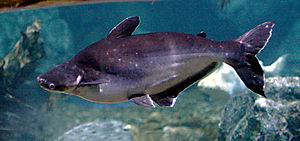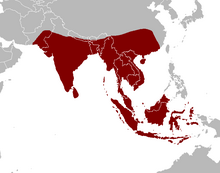Shark catfish
| Shark catfish | ||||||||||||
|---|---|---|---|---|---|---|---|---|---|---|---|---|

Pangasius ( Pangasianodon hypophthalmus ) |
||||||||||||
| Systematics | ||||||||||||
|
||||||||||||
| Scientific name | ||||||||||||
| Pangasiidae | ||||||||||||
| Bleeker , 1858 |
The shark catfish or slim catfish (Pangasiidae) are a family of fish from the order of the catfish-like (Siluriformes). They include 29 recent and two fossil species in five genera (one of which is fossil), the range of which extends from India via rear India to Indonesia , with most species in the Mekong and Mae Nam Chao Phraya ( Chao Phraya River ) and Borneo occurrence. Most of the species are pureFreshwater fish , only Pangasius pangasius and Pangasius kunyit , are also found in brackish water or even salt water . Many species are of great importance in the local fishery , some are also grown in aquaculture . The most important food fish are the pangasius ( Pangasianodon hypophthalmus ) and pangasius bocourti , which are also marketed frozen worldwide. In the wild, some species are in decline, the Mekong giant catfish ( Pangasianodon gigas ) and Pangasius sanitwongsei are considered to be critically endangered.
features
Shark catfish have a scaly, elongated, laterally flattened body. The short dorsal fin sits far forward on the body and has one or two hard rays and five to seven soft rays. A small adipose fin , which is always separated from the caudal fin , is present. The anal fin is elongated with 26 to 46 soft rays. The ribs number 39 to 52. Most species are medium-sized to large fish that reach body lengths of about half a meter to a little over a meter. The Mekong giant catfish and the species Pangasius pangasius and Pangasius sanitwongsei reach lengths of up to three meters and are among the largest freshwater fish in the world. Important distinguishing features between the genera and species are, in addition to the size and possibly existing drawing of the animals, the teeth of the palate, the structure of the swim bladder and the gill trap as well as the number of soft rays of the anal fin.
Way of life
Most species are freshwater fish that migrate between the spawning and feeding grounds depending on the water level. The food spectrum for most species is diverse and includes various invertebrates, fish and plants. In addition to generalists, there are also food specialists. The genus Helicophagus specializes in molluscs , Pangasius sanitwongsei is a pure predatory fish and adult Mekong catfish are pure herbivores.
Systematics
| Relationship of the recent shark catfish | |||||||||||||||||||||||||||||||||||||||||||||||||||||||||||||||||||||||||||||||||||||||||||||||||||||||||||||||||||||
|---|---|---|---|---|---|---|---|---|---|---|---|---|---|---|---|---|---|---|---|---|---|---|---|---|---|---|---|---|---|---|---|---|---|---|---|---|---|---|---|---|---|---|---|---|---|---|---|---|---|---|---|---|---|---|---|---|---|---|---|---|---|---|---|---|---|---|---|---|---|---|---|---|---|---|---|---|---|---|---|---|---|---|---|---|---|---|---|---|---|---|---|---|---|---|---|---|---|---|---|---|---|---|---|---|---|---|---|---|---|---|---|---|---|---|---|---|---|
|
|||||||||||||||||||||||||||||||||||||||||||||||||||||||||||||||||||||||||||||||||||||||||||||||||||||||||||||||||||||
| Cladogram of the shark catfish described up to 2000 according to Pouyard et al., 2000 |
The shark catfish comprise four recent genera with a total of 29 species . Molecular biological studies indicate that the genera Pangasianodon and Pseudolais are more closely related than with the genera Pangasius and Helicophagus .
- Family Pangasiidae (shark catfish) Bleeker, 1858
- Fossil genus Cetopangasius Roberts & Jumnongthai, 1999 ( Miocene , monotypic )
- Cetopangasius chaetobranchus Roberts & Jumnongthai, 1999
- Genus Helicophagus Bleeker, 1858
- Helicophagus leptorhynchus Ng & Kottelat, 2000
- Helicophagus typus Bleeker, 1857
- Helicophagus waandersii Bleeker, 1858
- Genus Pangasianodon Chevey, 1930
- Mekong giant catfish ( Pangasianodon gigas Chevey, 1931 )
- Pangasianodon hypophthalmus (Sauvage, 1878)
- Genus Pangasius Cuvier & Valenciennes, 1840
- Pangasius bocourti Sauvage, 1880
- Pangasius conchophilus Roberts & Vidthayanon, 1991
- Pangasius Djambal Bleeker, 1846
- Pangasius elongatus Pouyaud, Gustiano & Teugels, 2002
- Pangasius humeralis Roberts, 1989
- Fossil species Pangasius indicus (Marck, 1876) ( Eocene )
- Pangasius kinabatanganensis Roberts & Vidthayanon, 1991
- Pangasius krempfi Fang & Chaux, 1949
- Pangasius kunyit Pouyaud, Teugels & Legendre, 1999
- Pangasius larnaudii Bocourt, 1866
- Pangasius lithostoma Roberts, 1989
- Pangasius macronema Bleeker, 1851
- Pangasius mahakamensis Pouyaud, Gustiano & Teugels, 2002
- Pangasius mekongensis Gustiano, Teugels & Pouyaud, 2003
- Pangasius myanmar Roberts & Vidthayanon, 1991
- Pangasius nasutus (Bleeker, 1863)
- Pangasius nieuwenhuisii (Popta, 1904)
- Pangasius pangasius (Hamilton, 1822)
- Pangasius polyuranodon Bleeker, 1852
- Pangasius rheophilus Pouyaud & Teugels, 2000
- Pangasius sabahensis Gustiano, Teugels & Pouyaud, 2003
- Pangasius sanitwongsei Smith, 1931
- Pangasius silasi Dwivedi et al., 2017
- Genus Pseudolais Vaillant , 1902
- Pseudolais micronemus (Bleeker, 1846)
- Pseudolais pleurotaenia (Sauvage, 1878)
- Fossil genus Cetopangasius Roberts & Jumnongthai, 1999 ( Miocene , monotypic )
literature
- Tyson R. Roberts, Chavalit Vidthayanon: Systematic revision of the Asian catfish family Pangasiidae, with biological observations and descriptions of three new species . In: Proc. Acad. Nat. Sci. Philad. tape 143 , 1991, pp. 97-144 (English).
- Joseph S. Nelson: Fishes of the world . 4th edition. John Wiley & Sons, Hoboken 2006, ISBN 978-0-471-25031-9 , pp. 183 .
- Carl J. Ferraris, Jr .: Checklist of catfishes, recent and fossil (Osteichthyes: Siluriformes), and catalog of siluriform primary types . In: Zootaxa . tape 1418 , 2007, p. 1–628 (English, acnatsci.org [PDF]).
Web links
- Shark catfish on Fishbase.org (English)
- Shark catfish display board of Indonesia (Institut de Recherche pour le Développement, Jakarta) ( Memento from November 24, 2006 in the Internet Archive )
Individual evidence
- ↑ a b L. Pouyard, GG Teugels, R. Gustiano, M. Legendre: Contribution to the phylogeny of pangasiid catfishes based on allozymes and mitochondrial DNA . In: Journal of Fish Biology . tape 56 , 2000, pp. 1509-1538 (English).
- ↑ Dwivedi, AK, Gupta, BK, Singh, RK, Mohindra, V., Chandram S., Easawarn, S., Jena, J. & Lal, KK (2017): Cryptic diversity in the Indian clade of the catfish family Pangasiidae resolved by the description of a new species. Hydrobiologia, April 2017. doi: 10.1007 / s10750-017-3198-z
